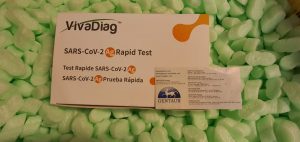The Cas13a system has nice potential in RNA interference and molecular diagnostic fields. Nevertheless, missing tips for crRNA design hinders sensible purposes of the Cas13a system in RNA enhancing and single nucleotide polymorphism identification. This research posits that crRNAs with hairpin spacers enhance the specificity of CRISPR/Cas13a system (termed hs-CRISPR).
Gibbs free power evaluation means that the hairpin-spacer crRNAs (hs-crRNAs) suppress Cas13a’s affinity to off-target RNA. A hepatitis B virus DNA genotyping platform is established to additional validate the high-specificity of hs-CRISPR/Cas13a system. In comparison with abnormal crRNA, hs-crRNAs enhance the specificity by threefold with out sacrificing the sensitivity of the CRISPR/Cas13a system. Moreover, the mechanism of the Cas13a/hs-crRNA/goal RNA composition is elucidated with theoretical simulations. This work builds on the basic understanding of Cas13a activation and presents vital enhancements for the rational design of crRNA for the CRISPR/Cas13a system.
Driving to Security: CRISPR-Primarily based Genetic Approaches to Decreasing Antibiotic Resistance
Bacterial resistance to antibiotics has reached vital ranges, skyrocketing in hospitals and the surroundings and posing a serious risk to world public well being. The complicated and difficult drawback of decreasing antibiotic resistance (AR) requires a community of each societal and science-based options to protect essentially the most lifesaving pharmaceutical intervention identified to drugs.
Along with growing new courses of antibiotics, it’s important to safeguard the scientific efficacy of present medicine. On this evaluation, we look at the potential software of novel CRISPR-based genetic approaches to decreasing AR in each environmental and scientific settings and prolonging the utility of significant antibiotics.
CRISPR/Cas-Dependent and Nuclease-Free In Vivo Therapeutic Gene Modifying
Exact gene manipulation by gene enhancing approaches facilitates the potential to remedy a number of debilitating genetic problems. Gene modification stimulated by engineered nucleases induces a double-stranded break (DSB) within the goal genomic locus, thereby activating DNA restore mechanisms. DSBs triggered by nucleases are repaired both by the nonhomologous end-joining or the homology-directed restore pathway, enabling environment friendly gene enhancing.
Whereas there are a number of ongoing ex vivo genome enhancing scientific trials, present analysis underscores the therapeutic potential of CRISPR/Cas-based (clustered repeatedly interspaced brief palindrome repeats-associated Cas nuclease) in vivo gene enhancing. On this evaluation, we offer an outline of the CRISPR/Cas-mediated in vivo genome remedy purposes and discover their potential scientific translatability to deal with human monogenic problems.
As well as, we focus on the varied challenges related to in vivo genome enhancing applied sciences and methods used to avoid them. Regardless of the strong and exact nuclease-mediated gene enhancing, a promoterless, nuclease-independent gene concentrating on technique has been utilized to evade the drawbacks of the nuclease-dependent system, reminiscent of off-target results, immunogenicity, and cytotoxicity. Thus, the quickly evolving paradigm of gene enhancing applied sciences will proceed to foster the progress of gene remedy purposes.
CRISPR/Cas: Advances, Limitations, and Functions for Precision Most cancers Analysis
Most cancers is likely one of the most main causes of mortalities worldwide. It’s attributable to the buildup of genetic and epigenetic alterations in 2 kinds of genes: tumor suppressor genes (TSGs) and proto-oncogenes. Lately, growth of the clustered repeatedly interspaced brief palindromic repeats (CRISPR) know-how has revolutionized genome engineering for various most cancers analysis ranging for analysis starting from elementary science to translational drugs and exact most cancers remedy. The CRISPR/CRISPR related proteins (CRISPR/Cas) are prokaryote-derived genome enhancing programs which have enabled researchers to detect, picture, manipulate and annotate particular DNA and RNA sequences in varied kinds of dwelling cells.
The CRISPR/Cas programs have vital contributions to discovery of proto-oncogenes and TSGs, tumor cell epigenome normalization, focused supply, identification of drug resistance mechanisms, growth of high-throughput genetic screening, tumor fashions institution, and most cancers immunotherapy and gene remedy in clinics. Sturdy technical enhancements in CRISPR/Cas programs have proven a substantial diploma of efficacy, specificity, and adaptability to focus on the particular locus within the genome for the specified purposes.
Latest developments in CRISPRs know-how presents a major hope of medical remedy in opposition to most cancers and different lethal illnesses. Regardless of vital enhancements on this subject, a number of technical challenges must be addressed, reminiscent of off-target exercise, inadequate indel or low homology-directed restore (HDR) effectivity, in vivo supply of the Cas system elements, and immune responses. This research goals to overview the current technological developments, preclinical and views on scientific purposes of CRISPR together with their benefits and limitations. Furthermore, the potential purposes of CRISPR/Cas in exact most cancers tumor analysis, genetic, and different exact most cancers therapies mentioned.

Engineered extracellular vesicles as versatile ribonucleoprotein supply autos for environment friendly and secure CRISPR genome enhancing
Transient supply of CRISPR-based genome enhancing effectors is essential to scale back off-target results and immune responses. Not too long ago extracellular vesicles (EVs) have been explored for Cas9 ribonucleoprotein (RNP) supply. Nevertheless, lack of mechanisms to counterpoint RNPs into EVs restricted the effectivity of EVs as a RNP supply automobile. Right here we describe a mechanism to actively enrich RNPs into EVs. We used the particular interplay between RNA aptamer and aptamer-binding protein (ABP) to counterpoint RNPs into EVs.
We inserted RNA aptamer com into single information RNA (sgRNA), and fused com-binding ABP Com to each termini of tetraspan protein CD63 that’s ample in exosomes. We discovered that the Com/com interplay enriched Cas9 and adenine base editor (ABE) RNPs into EVs, through forming a three-component complicated together with CD63-Com fusion protein, com-modified sgRNA and Cas9 or ABE. The RNP enriched EVs are environment friendly in genome enhancing and transiently expressed.
[Linking template=”default” type=”products” search=”Mouse Total IgG2a Antibody Detection Kit” header=”3″ limit=”126″ start=”1″ showCatalogNumber=”true” showSize=”true” showSupplier=”true” showPrice=”true” showDescription=”true” showAdditionalInformation=”true” showImage=”true” showSchemaMarkup=”true” imageWidth=”” imageHeight=””]
The system is able to delivering RNPs concentrating on a number of loci for multiplex genome enhancing. As well as, Cas9 from completely different species can be utilized collectively. The EV-delivered RNPs are lively in vivo. The info present that the aptamer and ABP interactions will be utilized to actively enrich RNPs into EVs for improved genome enhancing effectivity and security.

